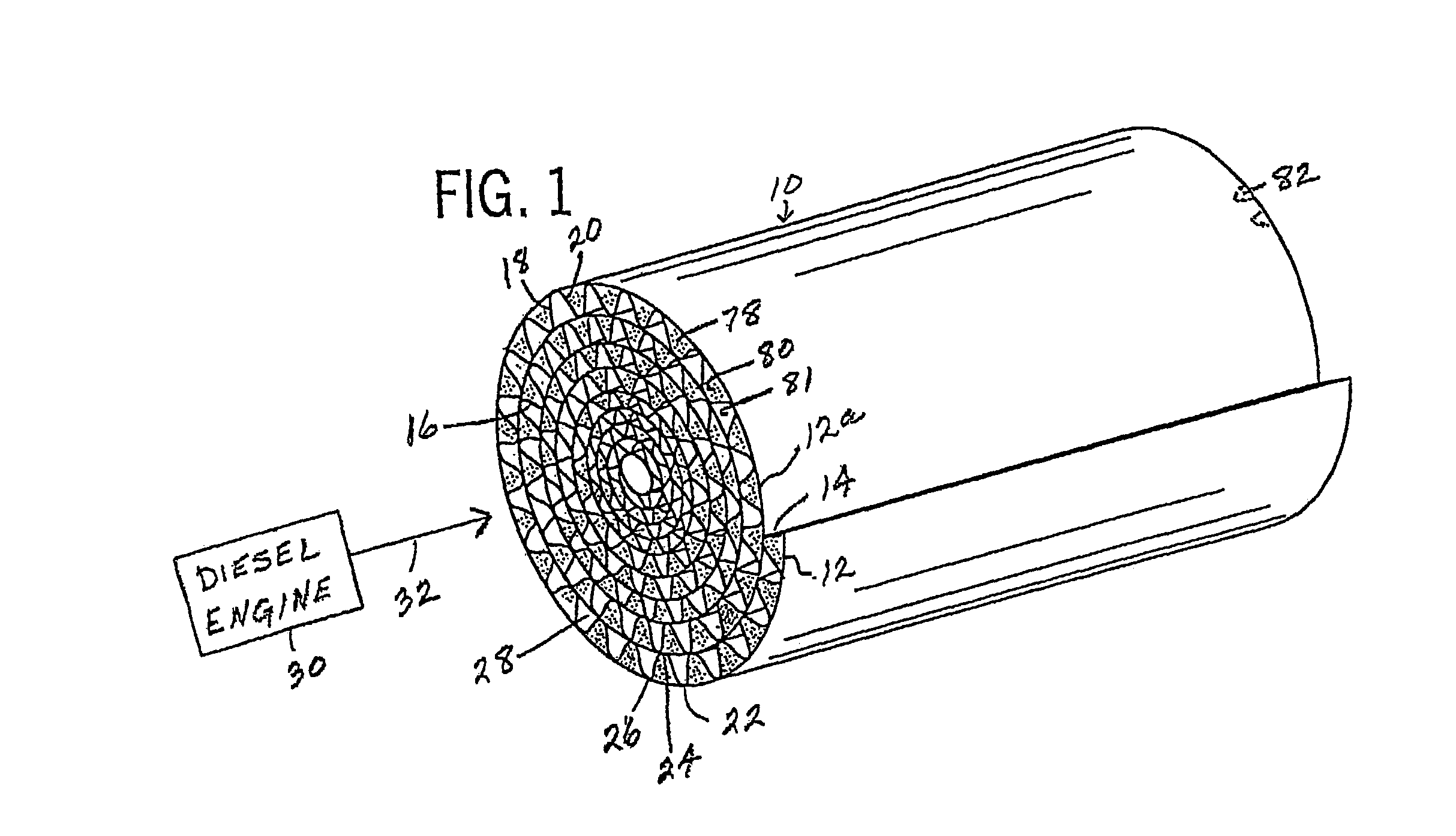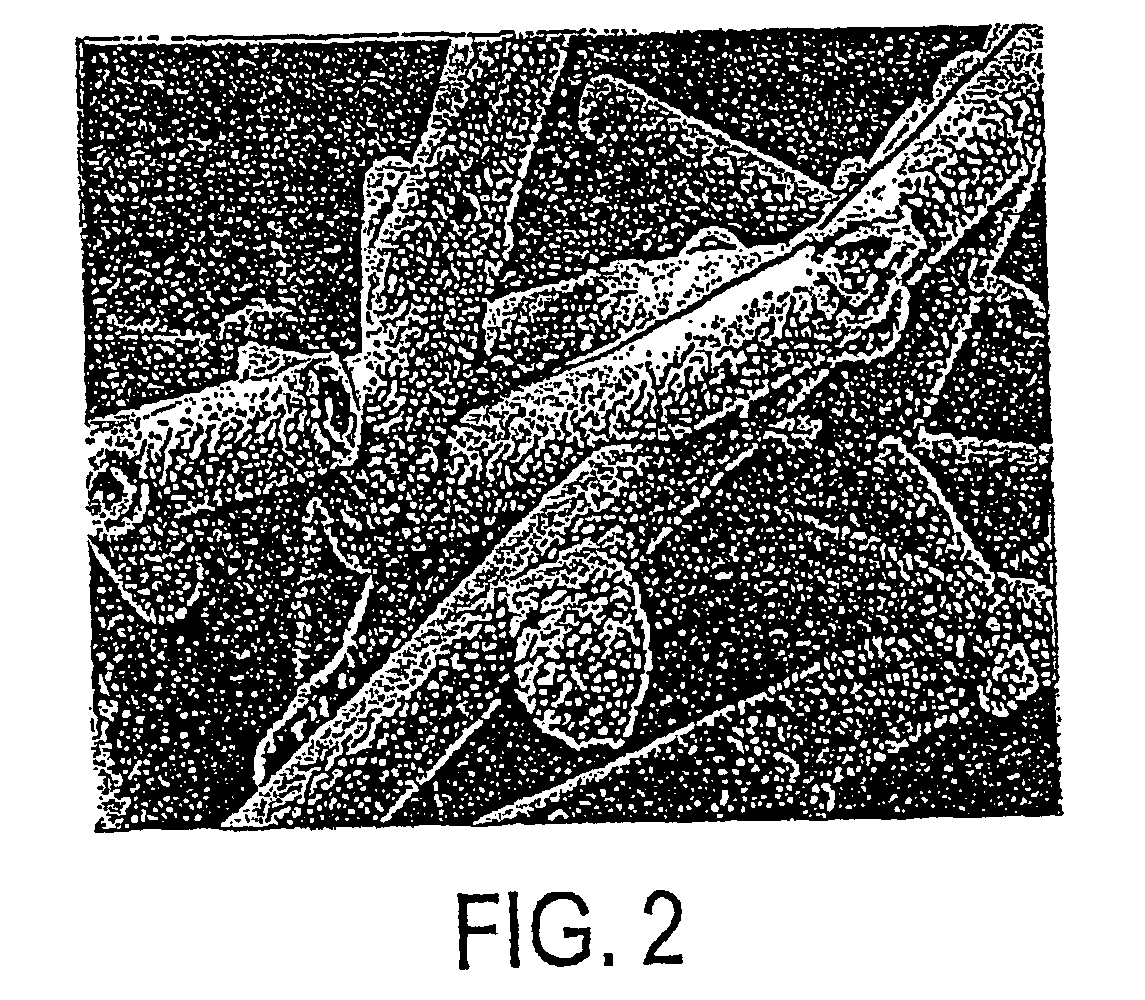High temperature nanofilter, system and method
a nanofilter and high temperature technology, applied in the field of high temperature filters, can solve the problems of high restriction, high thermal mass, low capacity, etc., and achieve the effects of less laminar flow, less adversely affecting the performance of the final filter product, and more structural stability
- Summary
- Abstract
- Description
- Claims
- Application Information
AI Technical Summary
Benefits of technology
Problems solved by technology
Method used
Image
Examples
example i
[0154]10.5 grams of alumina fibers having an average fiber diameter of 3 microns and length of about 0.01 to 10.0 mm was dispersed in 5000 grams of water to form a slurry or suspension. 1.8 grams of wood fibers were mixed along with 1.8 grams of KEVLAR® wet-pulp fibers in 1000 grams of water in a Waring blender and then added to the alumina fiber. Also added to the suspension was 2 grams of an acrylic latex binder containing 50% solids. The pH was reduced to 6.0 with the addition of aqueous alum. The suspension was further diluted with 15,000 grams of water. The slurry was then formed into a paper-like sheet using a conventional 12″×12″ square papermaking mold machine. The sheet was dried at a temperature of 150° C. and the resulting dried sheet had a porosity of 90%, a mean flow pore diameter of 12 microns, a weight of 150 grams per square meter, and a thickness of 0.95 mm.
[0155]Multiple sheets of paper were cut into sections each having a width size of 7.5 cm. One strip was corrug...
example ii
[0160]A green filter structure was prepared as described in Example I. The filter structure was then dipped in a 7% by weight colloidal suspension of alumina and the part was then air dried and then heated to a temperature of 250° C. to remove all solvents and dehydrate water. Subsequently, the part was fired at a temperature of 1100° C. in air to remove all the organic components, thus resulting in a structure consisting primarily of haphazardly arranged ceramic fibers and inorganic binders.
[0161]The filter structure was then subjected to a chemical vapor deposition process to coat the fibers and the intersections between fibers with a coating of silicon carbide, as described in Example 1.
[0162]The '490 patent provides a green uncured pre-form 10, FIG. 1, for an exhaust aftertreatment control filter. The pre-form includes first and second sheets 12 and 14 of regenerable filter material, as described above. Sheet 14 has a plurality of pleats such as 16 defined by wall segments 18, 2...
example 1
[0263]A primary dispersion was prepared by charging 87.0 g Dispersion III to a beaker and adding 13.0 g of isopropyl alcohol while stirring with a magnetic stir bar. A series of 9 cm by 9 cm green, ceramic fiber, paper coupons were impregnated by immersing the entire coupon into the primary dispersion on one side for 10 seconds, turning the coupon over and immersing it in the dispersion for an additional 10 seconds. After impregnation, the coupons were hung vertically and air dried overnight at room temperature (about 25° C.). The air dried coupons were then dried in a vented oven at 100° C. for 30 minutes, and then calcined and fired in a vented box furnace in air using the following heating sequence: room temperature to 500° C. in 3 hours; hold at 500° C. for 1 hour; heat from 500° C. to 1100° C. in 2 hours; hold at 1100° C. for 1 hour; cool in furnace to room temperature. The fired coupons are referred to as Coupon A.
PUM
| Property | Measurement | Unit |
|---|---|---|
| Temperature | aaaaa | aaaaa |
| Fraction | aaaaa | aaaaa |
| Length | aaaaa | aaaaa |
Abstract
Description
Claims
Application Information
 Login to View More
Login to View More - R&D
- Intellectual Property
- Life Sciences
- Materials
- Tech Scout
- Unparalleled Data Quality
- Higher Quality Content
- 60% Fewer Hallucinations
Browse by: Latest US Patents, China's latest patents, Technical Efficacy Thesaurus, Application Domain, Technology Topic, Popular Technical Reports.
© 2025 PatSnap. All rights reserved.Legal|Privacy policy|Modern Slavery Act Transparency Statement|Sitemap|About US| Contact US: help@patsnap.com



